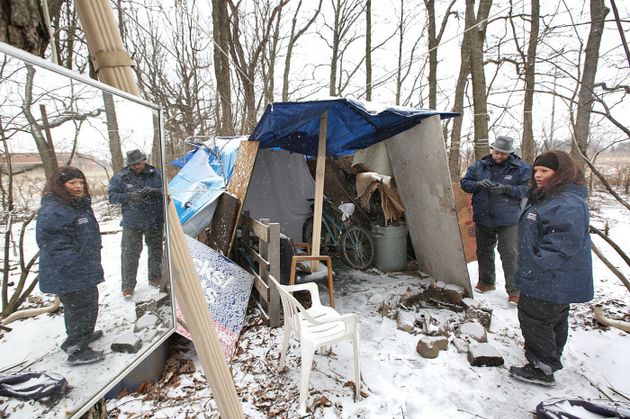There were about fifty people in the woods, behind a strip mall that sits right across from one of the largest outlet malls on the east coast. There were clusters of tents and a shack or two. Looking carefully, I could see the winding paths that led me to another way of life. My first visit was a novelty. My grandson and I had arranged with one of the homeless men at the camp in the woods to bring the group produce from a nearby food pantry. I’ll call him Sam. He was tall and led us to his site, which seemed to be very well organized. We didn’t speak long and he thanked us for the meals our church had brought earlier in the week. The air-conditioning in our car revived us from the stifling heat that hung in the woods that early July day.
A group of us continued bringing produce from the farmer’s market, chickens from Costco, and some gas for the one or two generators that powered some small fans fighting the oppressive heat. We continued this routine for a while and spent time getting to know the men and several women who called these woods home. “I’ll be glad when the fall comes,” a guy named Billy said.
We were all new to helping the homeless, but it soon dawned on us that produce, chickens and gas weren’t really the answer. As we became familiar with the people in the woods, we learned about them and realized their lives were complicated; that divorces, job losses, arrests, addictions, or chronic health issues had led them into the woods. In some cases, events unfolded abruptly. In others, it took a string of setbacks before they claimed the spot on which they set-up their tents. We gave them money at times. It seemed they always needed little things; that is, until we had to shell out $200 to get Randy’s car out of the impoundment lot so he could travel a considerable distance to his job.
As we tried to help, we realized we really didn’t have a plan, so we decided to give money to groups we were told were more expert in helping the homeless. We still visited the homeless; many who by now had become our friends. We took them out to dinner occasionally, tried to interpret undecipherable forms and letters they received from county and state aid agencies and recognized each individual required more help and guidance than we could provide.
Remember how Billy was looking forward to the fall? Well, fall was short-lived that year and winter rolled-in with chilling winds and heavy snows. We brought shoeboxes full of toiletries and other notions. Billy even erected a beat-up Christmas tree. He situated it near a memorial of Christmas decorations dedicated to his twenty-five-year-old friend, Mantu, who froze to death one night outside his tent. Our friend, Sam, who had become increasingly ill, almost died one sub-freezing night when someone stole his propane heater. Such was Christmas that year in the homeless camp.
We were able to get Sam into transitional housing, but his medical condition was beyond what the home could accommodate. He was asked to leave. The snow had been replaced by the brutal heat of July, and his overall health declined rapidly. We tried to get him into a facility, but were told there was a two-year waiting list at most places. We spoke to another agency and they said they’d be pleased to help, but he’d need a fixed address. There was also little help available from non-profits.
We did eventually find a small studio apartment for Sam, and then one for Billy. We schooled ourselves in learning to navigate the bureaucratic tangle of regulations that tried to discourage us from finding out the types of assistance to which they were entitled.
You see, most homeless people don’t have cars to get to assistance offices, and they don’t have computers to complete forms online. They don’t understand the importance of seeking medical help for a problem before it worsens. Many individuals, church groups, and non-profits — while well-meaning — often support competing programs, and local governments provide inadequate funds to address the problem.
Sam and Billy have become family to us, and we’re going to continue taking care of them as family. Who would have thought that could have developed from our initial trip into the woods? There are plenty of other Sam’s and Billy’s who desperately need help, especially this winter. If you would like to help, check out non-profits and houses of worship in your area who work with the homeless. Any amount of time you have, can help those so in need.
Rich Garon is the author of Felling Big Trees, a novel about a congressman turning from politics to make a positive change. All proceeds benefit WhyHunger.org.
To see the entire article, click here.

